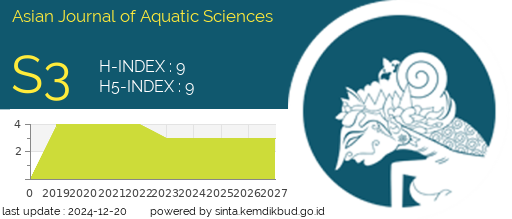HISTOPATHOLOGICAL OF STRIPED CATFISH (Pangasianodon hypophthalmus) REARED IN DIFFERENT SALINITIES
DOI:
https://doi.org/10.31258/ajoas.8.1.1-6Keywords:
P. hypophthalmus, histopathological, Salinity, Gill, KidneyAbstract
This study aimed to discover the effects of different salinities on histopathological Pangasianodon hypophthalmus. The method used is experimental by applying a completely randomized design (CRD) with four treatments: salinity 0 ppt, salinity 5 ppt, salinity 7 ppt, and salinity 9 ppt. The fish specimen is 8-10 cm in length and weighs 5 g. It was raised in a 54 L tank containing 40 L of water at a density of 2 fish 1 L-1 and kept for 45 days. Feed with commercial pellet 3 times a day in satiation. The results showed histopathological changes in gills and kidneys occurred at a salinity of 9 ppt. Chloride cell hypertrophy and secondary lamella bend in the gill organs, while the kidneys have acute tubular necrosis. Meanwhile, a salinity of 7 ppt resulted in abnormalities in the kidney organs with hemorrhage. It can be concluded that a salinity of 5 ppt indicates a safe salinity condition for the maintenance of striped catfish.
Downloads
References
1. Arafani, L., Mursal, G., & Ali, M. Pelacakan Virus Bercak Putih pada Udang Vaname (Litopenaeus vannamei) di Lombok dengan Real-Time Polymerase Chain Reaction. Jurnal Veteriner, 2016; 17(1): 88-95.
2. Kumar, A., Harikrishna, V., Reddy, A.K., Chadha, N.K., & Babitha, R.A.M. Salinity Tolerance of Pangasianodon hypophthalmus in Inland Saline Water: Effect on Growth, Survival and Haematological Parameters. Enviro Biotech Journals, 2017; 23(1): 568-575.
3. Hossain, F., Islam, S.M., Islam, M.S., & Shahjahan, M. Behavioral and Histo-Pathological Indices of Striped Catfish (Pangasionodon hypophthalmus) Exposed to Different Salinities. Aquaculture Reports, 2022; 23, 101038
4. Riswan, M., Syawal, H., & Tang, U.M. Osmotic Performance and Growth Rate of Striped Catfish (Pangasianodon hypohthalmus) at Different Salinity. Asian Journal of Aquatic Sciences, 2022; 5(1): 10-19
5. Phuong, L.M., Huong, D.T.T., Nyenggaard, J.R., & Bayley, M. Gill Remodelling and Growth Rate of Striped Catfish Pangasianodon hypophthalmus under Impacts of Hypoxia and Temperature. Comp. Biochem. Physiol, 2017; 203:288–296
6. Foyle, K.L., Hess, S., Powell, M.D., & Herbert, N.A. What is Gill Health, and What is its Role in Marine Finfish Aquaculture in the Face of a Changing Climate?. Frontiers in Marine Science, 2020; 7: 400.
7. Ros, A., Schmidt‐Posthaus, H., & Brinker, A. Mitigating Human Impacts Including Climate Change on Proliferative Kidney Disease in Salmonids of Running Waters. Journal of Fish Diseases, 2022; 45(4): 497-521.
8. Fitrani, M., Nirmala, K., & Affandi, R. Rekayasa Lingkungan Budidaya untuk Meningkatkan Mutu Produk Ikan Patin Siam (Pangasius hypophthalmus): Peran Salinitas. Prosiding Forum Inovasi Teknologi Akuakultur, 2009: 461-474.
9. Raškoviæ B.S., Stankovi M.B., Markovi Z.Z., & Poleksi V.D. Histological Methods in the Assessment of Different Feed Effects on Liver and Intestine of Fish. Journal of Agricultural Sciences, 2011; 56(1): 87-100.
10. Windarti, W., & Simarmata, A.H. (2015). Buku Ajar Histologi. Penerbit Unri Press. Pekanbaru. 2015; 105 pp.
11. Dawood, M.A., Noreldin, A.E., & Sewilam, H. Blood Biochemical Variables, Antioxidative Status, and Histological Features of Intestinal, Gill, and Liver Tissues of African Catfish (Clarias gariepinus) Exposed to High Salinity and High-Temperature Stress. Environmental Science and Pollution Research, 2022; 29(37): 56357-56369.
12. Hwang, P. P., Lee, T. H., & Lin, L. Y. Ion Regulation in Fish Gills: Recent Progress in the Cellular and Molecular Mechanisms. American Journal of Physiology-Regulatory, Integrative and Comparative Physiology, 2011; 301(1): 28-47.
13. Nirmala, K., Hastuti, Y.P., & Yuniar, V. Toksisitas Merkuri (Hg), Tingkat Kelangsungan Hidup, Pertumbuhan, Gambaran Darah, & Kerusakan Organ pada Ikan Nila Oreochromis niloticus. Jurnal Akuakultur Indonesia, 2012; 11(1): 38-48.
14. Jiang, Y., Yuan, C., Qi, M., Liu, Q., & Hu, Z. The Effect of Salinity Stress on Enzyme Activities, Histology, and Transcriptome of Silver Carp (Hypophthalmichthys molitrix). Biology, 2022; 11(11):1580
15. Pulungan, C.P., Windarti, W., Pamukas, N.K., Riauwaty, M., Asiah, N., & Heltonika, B. Buku Ajar Fisiologi Hewan Air. UR Press Pekanbaru. Pekanbaru. Riau. 2015; 114 pp.
16. Bjørgen, H., & Koppang, E.O. Anatomy of Teleost Fish Immune Structures and Organs. Principles of Fish Immunology: From Cells and Molecules to Host Protection, 2022; 1-30.
17. Jamin, J., & Erlangga, E. Pengaruh Insektisida Golongan Organofosfat terhadap Benih Ikan Nila Gift (Oreochromis niloticus, Bleeker): Analisis Histologi Hati & Insang. J. Acta Aquatica, 2016; 3(2): 46-53.
18. Diba, D.F., & Rahman, W.E. Gambaran Histopatologi Hati, Lambung & Usus Ikan Cakalang (Katsuwonus pelamis) yang Terinfestasi Cacing Endoparasit. J. Octopus, 2018; 7(2): 24-30.
19. Mandia, S., Marusin, N., & Santoso, P. Analisis Histologis Ginjal Ikan Asang (Osteochilus hasseltii) di Maninjau & Singkarak, Sumatera Barat. J. Bio. UA, 2013; 2(3): 194-200
20. Lutfiyah, L., Budi, D.S., & Ulkhaq, M.F. (2021). Efek Pestisida Organofosfat Subletal terhadap Respons Fisiologis dan Histopatologi Ikan Wader Pari (Rasbora argyrotaenia). Journal of Fisheries Science and Laboratory Management, 2021; 1(2): 43-50
Downloads
Published
Issue
Section
License
Copyright (c) 2025 M Riswan, Henni Syawal, Usman M Tang, Irwan Effendi, Ronal Kurniawan, Sri Wahyuni, Mega Novia Putri (Author)

This work is licensed under a Creative Commons Attribution 4.0 International License.






